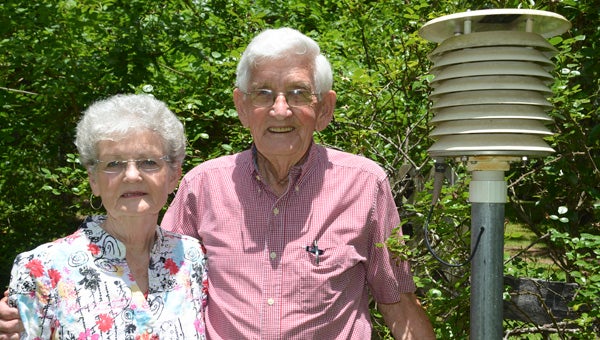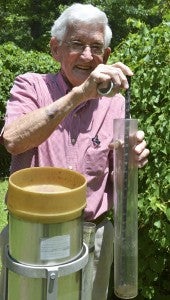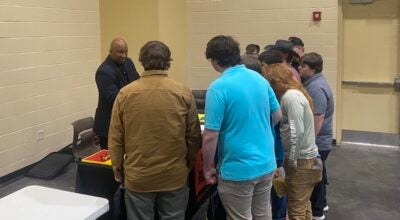Clanton weather recording station oldest in the state
Published 5:22 pm Friday, June 27, 2014
Every morning at 7 a.m. since 1990, C.A. Turner has recorded the daily temperature and rainfall totals in Clanton for the National Weather Service in Calera.
“I have just always enjoyed keeping up with it,” Turner, 87, said. “I have a tablet that I keep the records in and I write down the maximum (high), minimum (low) and current temperature, I write down if it thundered that day and I write down how much rain or snowfall we got.”
Turner “officially” retired from recording the temperatures for the NWS in May, but plans to continue recording the weather observations “for fun” due to his enjoyment of recording the data.
“I thought someone else could take it over because I’m not getting any younger,” Turner said. “I do enjoy it though.”
Turner sat in his living room off Hinkle Road showing his wire bound notebook with tiny, handwritten numbers, neatly nestled in hand drawn columns, the weather records throughout the years.
On Turner’s property sits the Clanton Cooperative Observing Station, officially known as CLNA1, which is one of the longest, consistent reporting stations and oldest in Alabama.
The Clanton station was established in February 1893 near the area of the current Clanton Post Office.
Since 1893, daily measurements of maximum/minimum temperature, rainfall and snowfall for the Clanton area have been recorded at 7 a.m. every morning, with few interruptions.
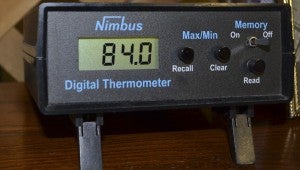
Pictured is the digital machine Turner reads each day to log the temperature. The machine is connected to a stand located outside of Turner’s home.
“The Clanton station is unique because of the few times it has been moved over the past 121 years,” said Kevin Laws, Chief Scientist at the National Weather Service in Birmingham. “It has always stayed in the guidelines of moving within five miles of the original location. If it moves beyond five miles, it would have to start the record over with a new station name, essentially wiping out the historical context of the local climate.”
Although there are no historical records of who the observers were before 1923, the weather records started with Hugh M. Simpson. Simpson started taking weather observations and the station was moved to 306 N. Fifth St., north of downtown.
Simpson retired after 30 years and the observations were temporarily taken over by Thomas E. Wyatt in May 1953. The station was moved back near the Clanton Post Office in a description that was simply recorded as “behind Dr. Johnson’s Office.”
In a more permanent move, the station was relocated in September 1953 to Fifth Ave. S. at the residence of Marion W. Easterling where daily observations were resumed until November 1987.
Easterling was a long time programmer at a gospel radio station and wrote several songs.
The next move came in April 1990 to Hinkle Road where Turner kept the daily observations until May 2014.
The station will soon be moved to the Clanton Water Treatment Plant off Pinedale Road in Clanton where the observations will continue.
Anthony Kelley will be the new Clanton weather observer when the station is relocated.
Laws said most counties in Alabama have someone who records the daily temperature and rainfall for the area.
“A lot of people back then recorded the weather because they were involved in agriculture,” Laws said. “It was important to them to know daily temperatures.”
Laws said individuals who record the weather are usually people who are “naturally interested in it.”
“We need someone who is reliable and someone we can count on to be accurate,” Laws said. “It is hard to find a station with a consistent longstanding record.”
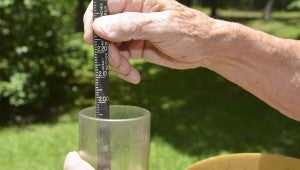
Turner, along with his wife, Imogene Turner, walk every morning before Turner walks to a small, silver tube that resembles a small rocket, in his yard where he checks the amount of rain Clanton might have received on any particular day. Pictured is the measuring device used to determine the amount of rainfall.
Laws said since 1923, the only gap in records was from November 1987 to April 1990.
“There is about a two-year gap where we don’t have any information,” Laws said. “That is really the only serious significant data we don’t have.”
Data collected from observing sites throughout the state is often used in applications concerning climate change and variability, water management and drought assessment.
The data also provides historical climate data and access to observations throughout the years.
Some of the weather data recorded throughout the years for Clanton includes:
•The hottest day on record in Clanton was a tie on Sept. 6 and Sept. 7, 1925 at 110 degrees. The coldest day was Feb. 13, 1899 when the low in Clanton was -9 degrees.
•The lowest high temperature occurred on Feb. 3, 1905, when the high only reached 16 degrees. The winter of 1905 had five consecutive days in January and four consecutive days in February where the temperature never got above 32 degrees. There were a total of 14 days in the winter of 1905 where the temperature never got above freezing.
The second coldest winter was 1996 when the temperature never got above freezing for seven days during the winter.
•The most one-day rainfall was on July 7, 1916 when Clanton received 11.23 inches of rain.
•The average monthly temperature for the hottest time is in July at 79.6 degrees and the coldest month is January at 43.1 degrees. The average yearly temperature in Clanton is 63.8 degrees.
•The warmest day of the year on average is July 22 and the coldest is Jan. 13.
•The average yearly rainfall is 54.1 inches and the wettest month is March with 6.17 inches and the driest month is October with 2.75 inches.
•From September-November 1978, Clanton went 39 straight days with no rainfall, although 1978 is only the 10th driest on record.
•In the year 1990, no day was above 90 degrees.
•The Clanton average snow for any given winter is 1.3 inches.
•Overall, the temperatures have shown a downward trend with time, decreasing around a half degree or so per decade on average, according to data recorded. The precipitation on average has not shown any up or downward trend over time.
Turner, along with his wife, Imogene Turner, walk every morning before Turner walks to a small, silver tube that resembles a small rocket, in his yard where he checks the amount of rain Clanton might have received on any particular day.
He then checks the temperatures with a small, digital machine where he logs the information for that day.
“Imogene has helped me write everything down throughout the years,” Turner said. “I then would call in to the weather station and punch in the numbers through an automated system they had set up. We would also mail in the observations every month to the weather station in Calera.”
Since recording the weather in 1990, Turner has never missed a day.
“If we were going to be out of town or something we would ask our neighbor to come over and record it for us,” Turner said. “I have never had a day since 1990 where I did not record the weather.”
Turner said his interest in weather has increased throughout the years and he now watches radars online for storms that might approach Chilton County.
“One thing I have learned throughout the years is we need to thank the good Lord that none of us can predict the weather,” Turner said. “The thing about weather is a lot of people are interested in it and it affects everyone. The only thing we can do is record it, or watch out for it, but none of us can predict it.”


